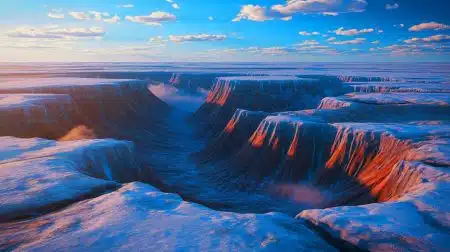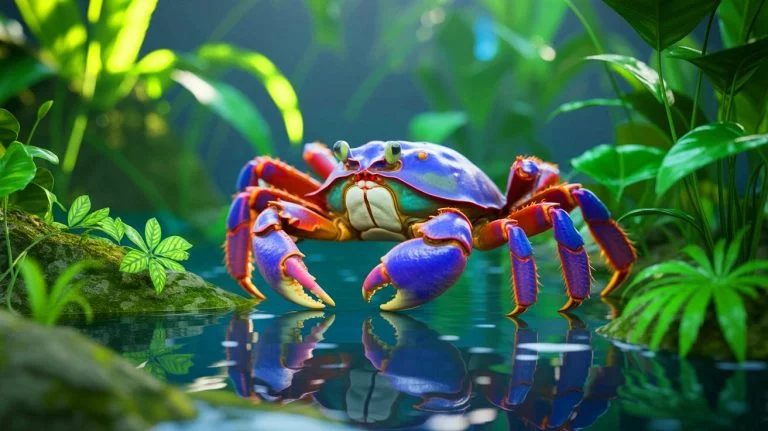| IN A NUTSHELL |
|
In the lush tropical forests of Southeast Asia, a small crustacean has captivated the attention of scientists and nature enthusiasts alike. Known as the “panda crab” for its distinctive markings, this creature has long intrigued biologists. Recently, an extraordinary purple variation was discovered in a Thai river, sparking renewed interest in this enigmatic species. As tourism and climate change threaten its habitat, the panda crab’s sudden appearance underscores the critical importance of preserving these hidden ecosystems, which are home to a wealth of undiscovered biodiversity.
The Enigmatic Panda Crab in Thai Rivers
The panda crab, scientifically classified under the genus Lepidothelphusa, inhabits the rocky, shallow streams of Thailand. Its square, slightly domed carapace measures just over an inch, yet its bold colors make it stand out. Ranging from bright white to deep black, and even more rarely, a profound violet, these colors have earned it the nickname “panda crab.” Officially, the species was named to honor Princess Maha Chakri Sirindhorn.
First described scientifically in 1903, the panda crab was not observed again until the 1980s in Thailand’s Ngao Waterfall Park. These semi-terrestrial crustaceans spend part of their lives out of water, concealed in the damp crevices of stones. Much about their biology remains unknown, especially regarding the recently photographed colorful forms.
In July 2025, park rangers in Kaeng Krachan captured new photos of a violet specimen just before the tourist season ended. This rare sighting, reported by Popular Science, was hailed by local ecologists as a “precious gift of nature,” highlighting the ecological significance of these elusive habitats.
Panda Crab as a Symbol of Protected Biodiversity
The panda crab is now a legally protected species in Thailand, recognized since 2019 not just for its unique appearance but also for its role as an ecological indicator. According to the Bangkok Post, its presence signifies a healthy forest environment capable of supporting species that demand stable, humid conditions.
Recent observations have occurred at roughly 330 feet above sea level, in areas where streams flow year-round. This preference for cool, isolated microhabitats makes the panda crab particularly vulnerable to climate change and human activities such as mass tourism and forest fragmentation.
In Kaeng Krachan National Park, a UNESCO World Heritage site, the discovery of a panda crab was celebrated as a testament to the area’s ecological vitality. The park is home to other iconic species, including leopards, hornbills, and the king cobra, forming a rich ecosystem that authorities are committed to preserving.
Hidden Life in Humid Forests
Away from tourist hotspots, Malaysian and Singaporean researchers have conducted detailed morphological analyses of Lepidothelphusa species. Their study, published in the Raffles Bulletin of Zoology, identifies at least six distinct species in Borneo, Indonesia, some residing at altitudes above 3,300 feet. Each species appears restricted to a small area, sometimes just a few square miles around a spring.
These findings highlight the significant, often underestimated biodiversity within tropical streams. The panda crab, whether white or violet, may only be a glimpse into a much larger, fragile ecosystem.
Observing these animals requires patience and keen observation, as they blend seamlessly with wet rocks. Some individuals have been rediscovered through photographs taken by hikers, demonstrating the value of collaboration between scientists and citizens in monitoring tropical wildlife. Far from being merely a curious plush-like crustacean, the panda crab now represents a living memory of Asia’s forests.
The panda crab’s story is a testament to the delicate balance of tropical ecosystems and the unseen biodiversity they harbor. As climate change and human encroachment continue to threaten these habitats, the question remains: how can we better protect the hidden treasures of our planet’s forests for future generations?
Did you like it? 4.5/5 (24)







Wow, a purple panda crab? Nature never ceases to amaze! 🌈🦀
Is there any hope for reversing the damage caused by tourism and climate change in these areas?
I would love to see these crabs in their natural habitat. Are there any guided tours available?
Such an incredible discovery! Thanks for sharing this amazing story. 😊
Is it real for real? A purple crab sounds like something from a sci-fi movie! 🤔
How do the researchers ensure that their presence doesn’t disturb the natural habitat of these crabs?